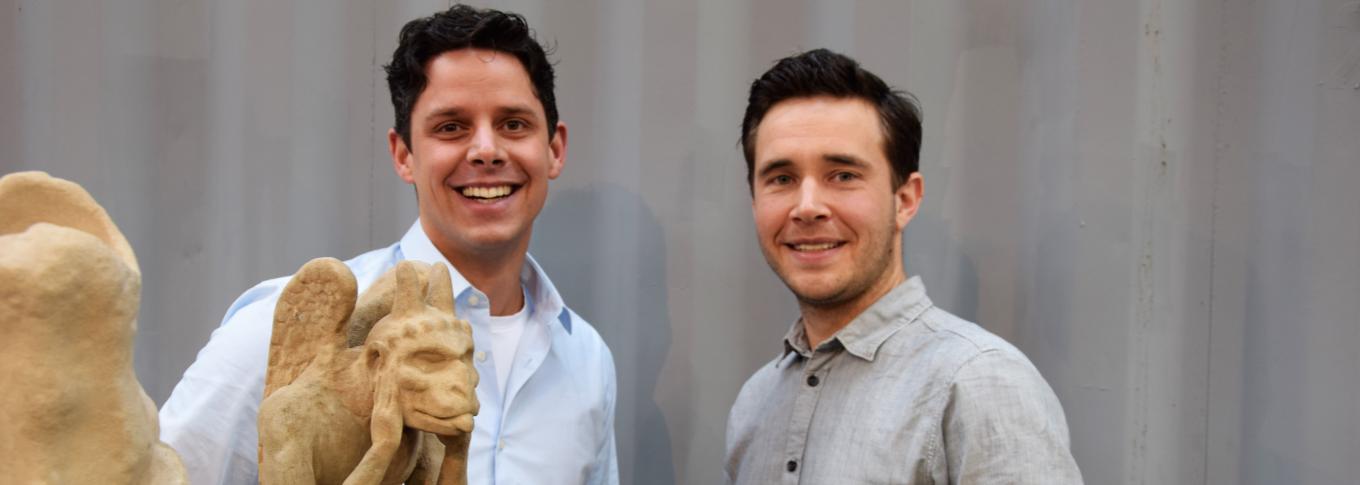
Festo automation technology aids restoration of Notre-Dame Cathedral
Rapid leaps in innovation characterise the development of additive manufacturing processes. Rotterdam-based company Concr3de has been working on a 3D printer for stone for more than five years, developing an inkjet technique to participate in the reconstruction of Notre-Dame Cathedral in Paris. They achieved this aim using automation technology from Festo.
Architectural applications were the catalyst for the development of Armadillo White, the inkjet 3D stone printer. The founders of Concr3de, architects Eric Geboers and Matteo Baldessari, started with a geopolymer - a material made by binding a residual product from the coal and steel industry with a chemical binder (“ink”). They proposed using the burnt remains of the Paris cathedral as raw material to repair the damaged masonry, because the lack of craftsmen and original raw materials made it difficult to reconstruct the destroyed parts using medieval techniques.
In order to develop their 3D printer, Concr3de needed components that would function reliably for a long time under difficult conditions and be easily scalable. The supplier's knowledge of software technology and service were also important to them.
Automation solutions
They identified Festo as a possible partner through similar 3D printing projects and asked Jeroen te Brake, additive manufacturing specialist at Festo Netherlands, for support. He used Festo’s EXCM product demo box to test that the printer principle worked and to identify an appropriate linear drive for the handling system to drive the movements of the print head. The Festo ELGA actuator was chosen for three reasons: it can have a positive pressure applied internally to prevent the ingress of dust, it can be supplied in long lengths, and it has a good protective cover. Festo also mounted the actuator upside down so that no dust could fall into it. In addition to the ELGA axis, the control system, the Z-axis components, and the fluid supply for the binder and piping also came from the Festo range.
Using data from Concr3de, Festo meticulously calculated the axes, gearbox, motor and control to obtain the correct inertia ratio. Integrating a Siemens controller was also easy. All Concr3de then had to do was drag the appropriate function blocks for the communication lines from Festo's standard software libraries into the right place. Thanks to Festo's configuration tool, only the positions to be moved had to be entered and a plan of each movement could be created. Festo provided engineering support and training to Concr3de throughout.
Rising from the ashes
The collaboration between Concr3de and Festo has been successful. Printing with the ashes of the building is not only much faster, but also gives the building a history. The necessary scans for the 3D reconstruction are available because American scientist Andrew Tallon fully 3D mapped the building in 2013. Concr3de used one of his scans to reconstruct a sculpture from Notre-Dame, a striga, which is a bird-like demon.
The company printed a 30cm high model of the stone carving, using limestone powder and a binder, in five hours. Tests at the Delft University of Technology have shown that the result is in no way inferior to real limestone.
About Festo
Festo is a leading international supplier of automation technology with a turnover in 2024 of around €3.45 billion. Festo employs over 20,000 people worldwide and is a proven innovator and problem solver in pneumatic and electrical automation, where it is the performance leader. Festo offers around 36,000 pneumatic and electric products in hundreds of thousands of variants for factory and process automation technology, many of which can be tailored to specific customer needs. Sustainability, reducing its CO2 footprint, digital learning, innovation, performance and speed are the key drivers for the company's future. Festo GB operates as a carbon neutral organisation and uses the PAS 2060 standard externally audited by NQA to validate this claim to customers, employees and other stakeholders.
Festo Industrial Automation's innovative strength is demonstrated through the launch of around 100 new products every year. The company invests over 8.5% of its turnover in R&D, resulting in over 2,600 patents held worldwide. For more information about the company's products and UK / Irish services, please visit: www.festo.com/gb and www.festo.com/ie
Festo and Industry 4.0 - Festo has engaged with the Industry 4.0 initiative from its inception: as a user, manufacturer and trainer. As a member of the steering group, the company has taken an active role in defining the core standards such as the RAMI model and the Administration Shell. Festo Didactic has installed Industry 4.0 Cyber-Physical Factory training hardware systems in many leading universities and training centres. It also provides Industry 4.0 training courses for change managers and practical workshops for employees. Industry 4.0 technologies such as OPC-UA communications are embedded in the latest generation products. For more information, go to www.festo.com/digitalisation
Festo Didactic training delivers training for industry – by industry. Combining Festo's industrial heritage with its future-focused manufacturing and engineering expertise to deliver courses for greater productivity and competitiveness. Offering a wide range of open courses, structured development programmes and tailor-made, customer-specific projects on technology and Industry 4.0 and the industry-leading online training suite, Festo LX. Festo also provides state-of-the-art training equipment solutions for industrial companies and educational institutions around the world. Festo Didactic has around 56,000 education customers worldwide. More information on Festo training and consulting services can be found at: www.festo.com/didactic
Festo Bionic Learning Network encapsulates the innovative nature of Festo, raising awareness and attracting talent to the company. Exploring the links between nature and technology opens new areas of innovation and demonstrates complex ideas in a stimulating and enjoyable way. Festo works with an alliance of internal R&D, external educational establishments and specialist companies to advance bionic solutions for automation applications of the future. The objective is to benefit from bionics as a source of inspiration and to realise these in industrial automation. For more information about Festo's Bionic Learning Network, please visit: www.festo.com/bionics


